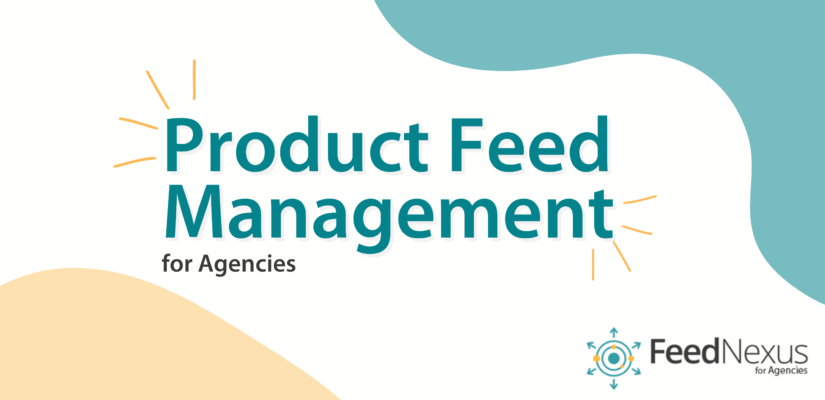
Product Feed Management for Agencies
An Essential Tool in E-commerce
Global online retail sales are projected to reach over USD 7 trillion by 2025. It’s a good idea, then, to capitalize on e-commerce in 2023 with nifty product feed management tools for agencies to help your business efficiently manage your clients’ stores.
Product feed management tools are essential for agencies to efficiently manage and optimize their clients’ product data. These tools streamline product data management and improve the accuracy and completeness of product feeds, saving time and resources for agencies. This article will uncover why a product feed management platform is useful for agencies; the agency user journey; and the added benefits of improving e-commerce efficiency with feed management.
FeedNexus for Agencies is a feed management solution for agencies working on behalf of retail clients and allows agencies to efficiently manage and optimize the product feeds of their clients, improving the performance and ROI of their client’s e-commerce businesses.
Using Product Feed Management Software
- Agencies can use product feed management tools to efficiently manage and optimize the product feeds of their clients, improving the performance of their clients’ e-commerce businesses.
- Agencies can use these tools to create and manage product feeds for multiple clients, streamlining their work and improving their efficiency.
- Agencies can use these tools to create and optimize product feeds for their clients, improving the performance of their clients’ e-commerce businesses, without being overly reliant on the client.
Agency User Journey
Choosing the shopping feed platform
All the agency needs to do is choose “FeedNexus for Agencies” on ShoppingFeeder.com, and select which option would suit them best:
- FeedNexus Basic features the same powerhouse software as ShoppingFeeder, with one-click multi-channel management, where unlimited users can manage multiple e-commerce stores.
- FeedNexus Advanced gives you some additional benefits, including store goals and AI A/B testing. Watch this space for its release!
FeedNexus can help manage clients’ from various online store platforms, including Shopify, WooCommerce, AdobeCommerce, OpenCart, and PrestaShop.
Setting up the product feed
The agency will work with the client to set up and configure the product feed, which typically involves exporting the client’s product data from their e-commerce platform and uploading it to the feed management software. Once this first step is complete, the agency won’t require too much back-and-forth with the client.
Mapping and optimizing the feed
The agency will map the client’s product data to the required format for the target channels (e.g. Google Shopping, Facebook Shopping, TikTok, Pinterest, etc.) and optimize the feed for better performance. This involves editing titles, descriptions, and other product attributes to better match the target audience and improve the chances of the products being shown to and purchased by consumers.
Ongoing feed maintenance and management
The agency will regularly check and update the product feed to ensure that it is accurate and up-to-date. This may involve adding new products, updating product information, and removing outdated or unavailable products. FeedNexus has the added perk of daily automated syncing, meaning that the agency will not need to sync the product feed manually.
SEO Ranking:
The user journey for agencies working with e-commerce clients using product feed management software from an SEO perspective typically involves the following steps:
Keyword research: The agency will conduct keyword research to identify relevant search terms and phrases that consumers are using to find the client’s products online.
Using product feed management software can help agencies effectively optimize e-commerce product feeds for SEO by streamlining the process of incorporating relevant keywords and phrases, and by ensuring that product data is consistent and accurate across all channels. This can help improve the visibility and ranking of the client’s products in search results, leading to increased traffic and sales.
Watch this SEO webinar with Paul Lombard to learn more about SEO rankability in e-commerce:
Advantages of Product Feed Management for Agencies
- Efficiency: Feed management software allows agencies to efficiently manage and optimize large numbers of products and multiple storefronts, saving time and effort compared to manually updating each channel separately.
- Accuracy: Feed management software can help ensure that product data is consistent and accurate across all channels, reducing the risk of errors or inconsistencies that could negatively impact sales.
- Scalability: As the client’s e-commerce business grows, the agency can easily scale up their product feed management efforts using feed management software.
- One centralized product feed URL to create single campaigns across multiple channels: The updated and optimized product data from the feed management platform is ready for campaign creation, without the need to log in and out of multiple marketing channels.

What happens when agencies don’t use feed management platforms?
- Inefficiency: Manually updating product data on each channel separately can be time-consuming and error-prone. The agency might be overwhelmed with continuous dialogue with the client when product feeds are outdated.
- Inconsistencies: Without feed management software, it can be difficult to ensure that product data is consistent across all channels, which can lead to confusion and decreased sales.
- Limited scalability: As the client’s e-commerce business grows, the agency may struggle to keep up with the increased workload of manually updating product data on multiple channels.
Conclusion
With product feed management tools, businesses can easily create and update product listings on multiple sales channels, optimize their product titles, descriptions, and other metadata for better search engine visibility, and track and analyze the performance of their product feeds. Additionally, these tools help businesses gain valuable insights into the performance of their product feeds, allowing them to identify opportunities for optimization, scalability, efficiency, and improvement.
